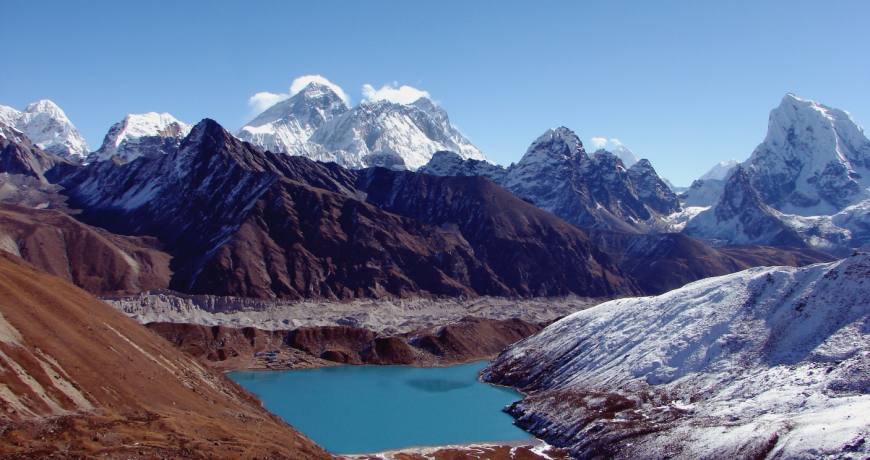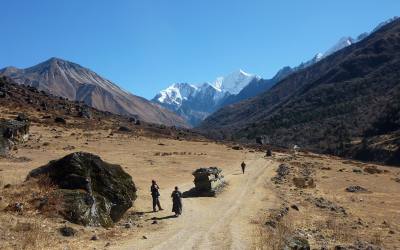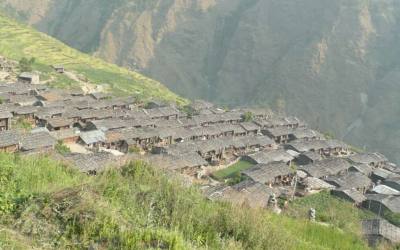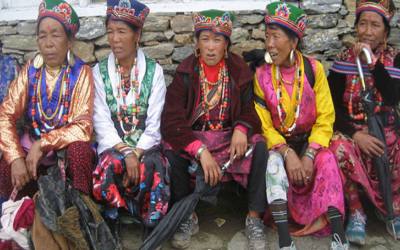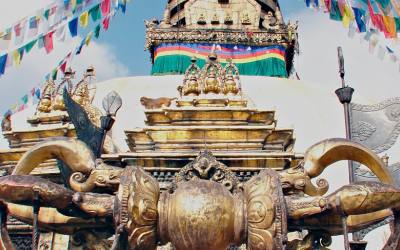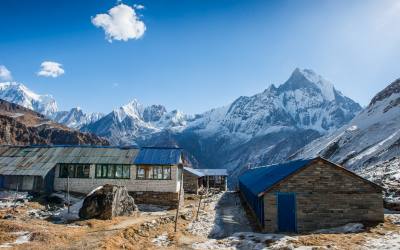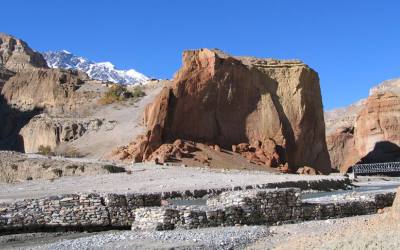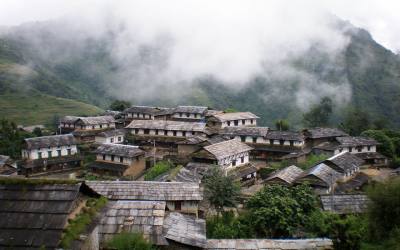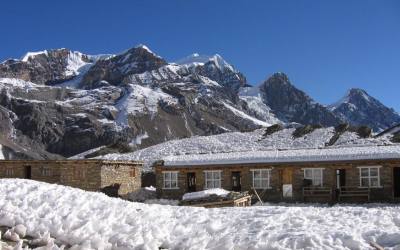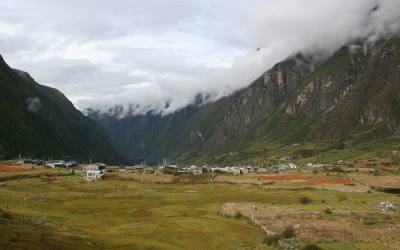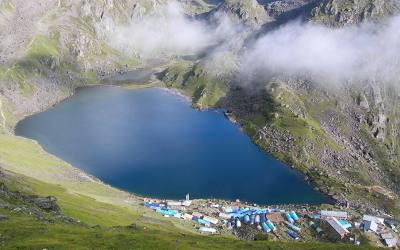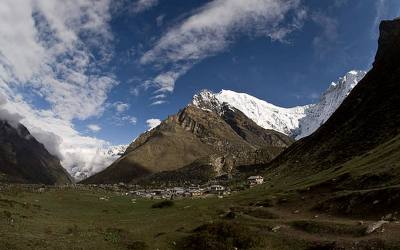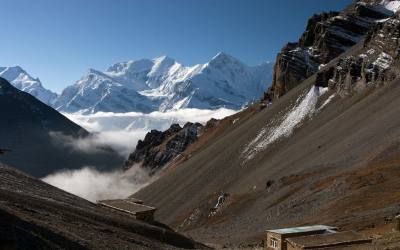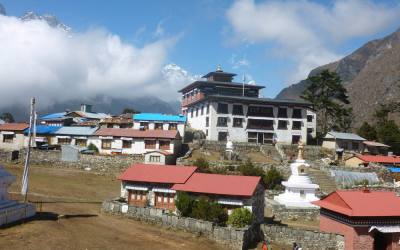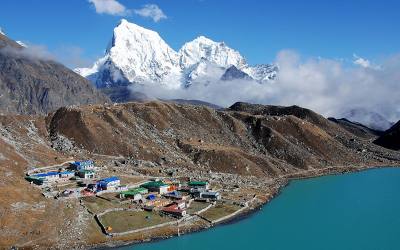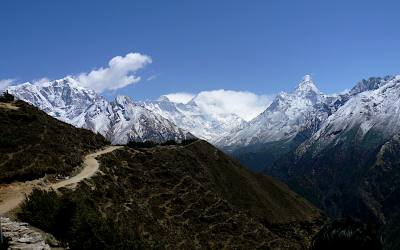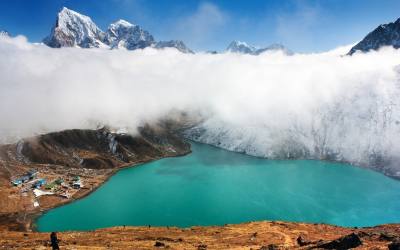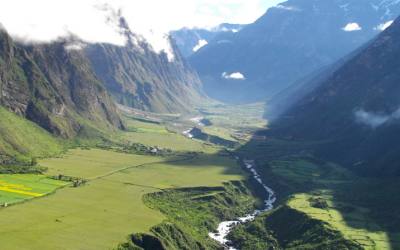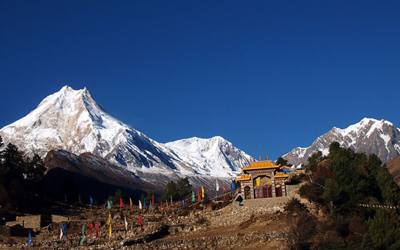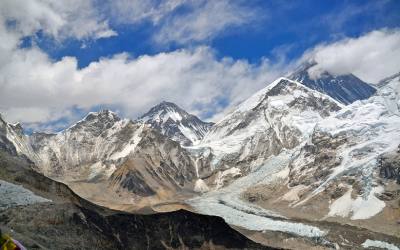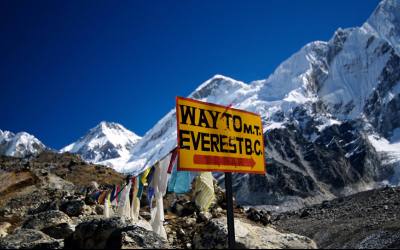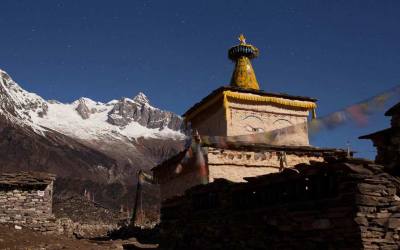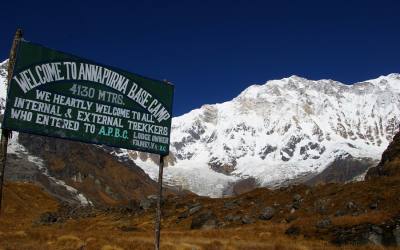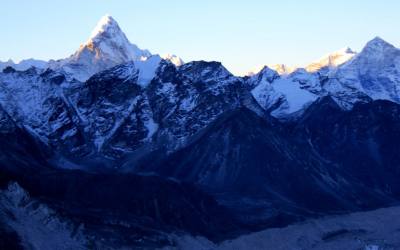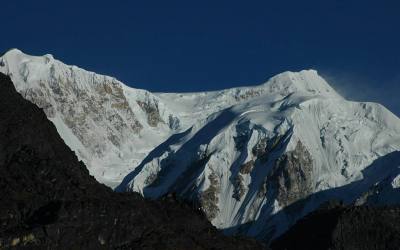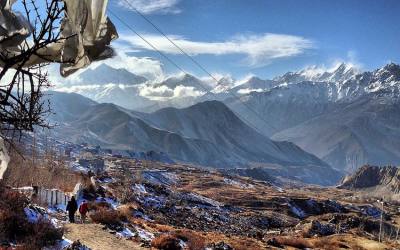The classic walk has clear cut goal to see Mt Everest. Many people find the sights along the way rival the climatic views of the world’s highest mountains Solukhumbhu, the home of legendary sherpas. the northern part of solukhumbu area is encompassed in the Everest national park, which was established to protect the fragile environment of this alpine region. To the east of Everest national park is the Makalu Barun national park, a remote and wild stretch of mountain peaks and deep densely forested valleys. To the west is Rolwaling valley, a well protected microcosm of cultures and ecology. Beside Everest there are three other 8000m peaks Lhotse(8516m) Makalu(8463m), Choyo(8201m)and in addition numerous other peaks of lesser altitude but no less stunning. Add to this glacial lakes, rhododendron forests, native flora and fauna, traditional villages and ancient Buddhist monasteries, all go to make this region a spectacular destination.
Gokyo valley is located in the west part of Khumbu and it is far less developed and crowded than its better known neighbour to the east. In fact, Gokyo valley has one traditional permanent settlement.
Gokyo Lake (4800m/15748 feet) Renjo la pass (5360m/17585feet) trekking is no doubt one of the most spectacular mountain areas in Everest region. This trek starts at the Lukla (2828m/9278 feet) and follows the Dudh Koshi valley which climbs up to the Sherpa capital of Namche. The trail to Gokyo is a gradual ascent up the valley passes through the patches of birch and rhododendron forest where the indescribable musk deer can sometimes be seen. Through small yak-grazing settlements, we reach to Gokyo lakes. An excursion to the Gokyo fourth and fifth lakes would be an attraction in Gokyo Valley. The Ngozumpa Glacier is the largest in the Nepal Himalayas. The Gokyo Ri (5330m/17487 feet) is considered as the best view point in the Everest Region. The incredible sceneries including magnificent views of Everest (8848m), Makalu (8463m), Cho Oyo (8201m),Lhotse (8516m) , Gyachung Kang (7922m) and other mountains. Set among breath-taking high mountain surroundings, the route leads through the Khumbu the motherland of Sherpa. The Renjo-La pass (5360m/17585feet) trek is crossing from Gokyo valley or Lumden. Renjo la pass gives an alternative way to the Gokyo trek making a circuit. Renjo la pass provides a lifetime memory of panoramic views of the Everest and others Himalayan range. The Renjo-La Pass route is off the usual beaten track. At the pass, a great view of the Gokyo lakes on one side, the Rermo Pokhari lakes on the other side, and a numerous of snowy peaks are in the background, which provide as incredible atmosphere.
People and culture
Sherpas are main ethnic group who lives around in this region. This is their heart land and their influence is to be seen everywhere from their traditional dress to their distinctive houses and monasteries. There are also minorities of various other groups. Like Rai, Tamang, Braman and Chhetri.
Flora and Fauna
Up to 4000m you will find dense stands of forest including pine, oak and the spectacular flowering rhododendrons. In spring all the hills are riot of colours. There is a good chance of seeing wildlife, mostly of them are birds. If you are lucky, you may will see musk deer, barking deer and Himalayan Thar.
Day 01: Arrival and transfer to Hotel in Kathmandu
Day 02: Fly out from Kathmandu. to Lukla then trek to Phakding(2652m)3-4 hrs of trek
Day 03: Phakding to Namche Bazaar ( 3446m): 6-7 hrs of trek
Day 04: Acclimatization day, visit Buddhist monastery, museum and other surroundings.5-6hrs of trek
Day 05: Namche Bazaar to Mongla(3970m) to Phortse Thanga- Dole(4038m) 4-5 hrs trek
Day 06: Trek to Machhermo (4465m) 4-5 hrs of trek
Day 07: Trek to Gokyo Lake (4720m) 5 hrs of trek
Day 08: Gokyo Rest day and Explore to Gokyori or trek to 5th lake and return back to Lukla. 6-7 hrs of trek
Day 09: Gokyo lake to Lunden (4300m) via Renjo pass 6-7 hours walking
Day 10: Lunden to Thame (3800m) 6 hours walking
Day 11: Thame to Monjo or to Phakding (2652m) 6-7 hrs of trek
Day 12: Lukla (2827m)(Trekking: approx 3½ hours) 4 hrs of trek
Day 13: Lukla to Kathmandu by air (1360m)
Day 14: Free day in Kathmandu (1360m) or self sightseeing tour
Day 15: Tour ends ( departure for onwards destination)
Day 01: Arrival and transfer to Hotel in Kathmandu
Upon arrival in Kathmandu. Our airport representative will be waiting outside the airport terminal a few metres from the exit door. Please check your name at play card. He will bring you to hotel in kathmandu. The drive from the airport to the hotel is around 20 minutes.
Hanumandhoka ( Kathamdnu Durbar Square ):
It is the historic seat of royalty. The Durbar Square , with its old temples and palaces, epitomizes the religious and cultural life of people. It is here that kings of Nepal are crowned and their coronations solemnized. Interesting things to see here are, Taleju temple built by king Mahendra Malla in 1954 AD, the temple of Kal Bhairab , the god of destruction, Nautale durbar, the statue of King Pratap Malla, the big drum and the Jaganath temple. It was listed in the UNESCO world heritage monument list in 1979.On the right hand corner, a large wooden lattice screen hides an enormous gilded face of Sweta Bhairab. The screen is removed only during the Indra Jatra festival.. there are also the Numismatic museum and Tribhuban museum inside the Hanuman Dhoka palace building . Photography is prohibited inside the museums. Both the mseums remain closed on Tuesday and government holidays.
Day 02: Fly out from Kathmandu. to Lukla to Phakding(2652m)(Trekking: approx 3 hours) In the early morning we take the spectacular flight from Kathmandu to Lukla (2827m), flying parallel to giant Himalayan mountains bordering Nepal and China (Tibet). The flight time is about 40 minutes . After landing we have time to explore the village while our Sherpa crew sort and load our trekking equipment. In the afternoon we begin our trek by descending towards the Dudh Kosi River where we join the main trail to Namche Bazaar, located just above Chaunrikharka (2713m). The walking is easy and after passing through the small village of Ghat (2550m) it is a short walk to Phakding.
Day 03: Phakding to Namche Bazaar ( 3446m): (Trekking: approx 7 hours) From Phakding we cross the river and head up the valley, following porters from the south that are ferrying supplies to Namche Bazaar. The trail keeps close to the river valley and is lined with beautiful blue pine and rhododendron forest that is very spectacular in the spring months, when the flowers are in bloom. We cross the Dudh Kosi River at Benkar, where there are tantalising glimpses of the snow-capped peaks of Kusum Kanguru (6369m) and Thamserku (6623m). From here it is only a short walk to Monjo (2835m), where we arrive in time for lunch. In the afternoon the walking is a little tougher and includes the steep ascent to Namche Bazaar. From Monjo it is a short walk to the entrance of the national park, before we cross the Dudh Kosi River to Jorsale (2805m). The trek continues upstream on generally flat terrain, crossing back to the right bank to the confluence of the Bhote Kosi and Dudh Kosi Rivers, where we start the steep climb to Namche Bazaar. After crossing a large and stable suspension bridge high above the river, we slowly ascend at a steady pace. There are some fantastic photographic opportunities as the peaks of Everest, Lhotse, Nuptse and Taweche (6542m) come into view for the first time.
Day 04: Acclimatization day, visit Buddhist monastery, museum and other surroundings.(Acclimatisation Day) We remain at Namche Bazaar for a second night to allow for proper acclimatisation to the altitude. Namche is a prosperous village situated in a large protected hollow. It gained its importance during the period when Tibetan salt was traded for the lowland grains of Nepal. Today a limited amount of trade still exists at Namche and Tibetans are often seen in the village trading rugs and Chinese-made goods, clothing, salt and dried meat. It is recommended that you take the opportunity to see both the sunrise and sunset views from the national park headquarters above the village. The stunning vista includes a superb panorama of the Khumbu peaks and great views of Everest. After breakfast, a variety of options exists. Perhaps a walk towards Thami (3810m) above the beautiful Bhote Khola River Valley or a visit to the national park headquarters to see the interesting displays of Sherpa lifestyle and culture. There is also a mountaineering display and information on the park’s flora and fauna. Your guides are on hand to offer advice and escort you on walks.
Day 05: Namche Bazaar to Mongla(3970m) to Phortse Thanga- Dole(4038m) (Trekking: approx 4 hours) From Namche, we ascend to the airstrip at Shyanboche and then to a lunch spot in Khumjung - the largest village in the region. Towering above Khumjung is the sacred rocky peak of Khumbilya (5761m). It is the home of the guardian goddess of the region, often depicted in religious paintings (or thangkas) as a white-faced figure on a white horse. The trail contours around Khumbilya’s lower slopes, passing through beautiful birch forest and then climbing on to treeless, grassy slopes to a stupa on top of a rocky ridge (3992m). Once again the views of the surrounding mountains are magnificent. Phortse can be seen across the valley - a picturesque village set in a patchwork of stone-walled fields. From the stupa we descend 300 metres on a series of switchback trails to the Dudh Kosi River at Phortse Bridge. The trail to Gokyo is deceptive and we can ascend too quickly if we do not plan our trekking days sensibly. So, in the interests of acclimatisation, we take three days to reach Gokyo. Leaving Phortse Bridge, we ascend steeply at first and then contour high above the valley, enjoying excellent views of Kantega, Thamserku and Ama Dablam (6856m). About an hour’s walk from Phortse Bridge, we gain our first views of the mammoth Cho-Oyo (8153m) at the head of the valley. We are now trekking beyond the tree line and pass some imposing waterfalls en route to the yak herding settlements of Tongba (4015m) and Gyele (4050m). From here it is a short distance to Dole (4084m), where we spend the night. After lunch we can explore the upper Dole Valley, returning via a high ridge above the lodge to enjoy fantastic views of Cho-Oyo and Gyachung Kang (7922m) to the north, and Taweche (6542m) and Cholatse (6440m) across the valley to the east.
Day 06: Trek to Machhermo (4465m)(Trekking: approx 3 hours) Today is another short day starting with a climb out of the small Dole Valley before ascending more gradually up the Dudh Kosi Valley, high above the river. The walk is easy though we will feel the effects of altitude on even the smallest hill. The barren alpine scenery with only small clusters of scrub juniper is a stark contrast to the snowy white peaks and deep blue skies. After two hours we arrive at Luza (4360m) and, after a further hour’s walk, we reach our lodge at Machhermo (4465m) where we spend the evening. After lunch there is an option of taking an excursion across rocky moraines to the base of Kyajo Ri (6168m) and Machhermo Peak (6073m
Day 07: Trek to Gokyo Lake (4720m)(Trekking: approx 3½ hours) A short, steep climb leads from the Machhermo Valley on to the steep grassy slopes of the Dudh Kosi Valley. Keep an eye open for the colourful Tibetan snow cocks, often found in this area. The valley widens as we pass through Pangka (4390m) and on to the jumbled, terminal moraines of Ngozumpa Glacier, the largest in Nepal and the source of the Dudh Kosi River. Climbing steeply over a rocky trail we keep to the western side of the glacier to reach a small lake at the head of a wide valley and then pass a larger lake at Longponga (4690m), before following the lateral moraines to the third lake at Gokyo (4750m). Gokyo consists of a number of stone dwellings surrounded by stone-walled yak pastures.
Day 08: Gokyo Rest day and Explore to Gokyori or to 5th lake (Rest and Exploration Day) Those who have opted for the morning views at Gokyo Ri have to rise early for an ascent of Gokyo Peak (5360m), while others can have a late breakfast and possibly take an optional walk up the Gokyo Valley to enjoy further magnificent scenery
Day 09: Gokyo lake to Lunden (4300m) 5 hours walking .After taking breakfast in the morning at 7:30, trek begin around 8:00am to cross Renjo La (5340m) on the other side of the lake form Gokyo. After cresting the pass, we will all drop down by the rope and then walk down to Lunde. This beautiful alpine valley is a trade route for Tibetan yak caravans heading to Namche Bazaar and was just recently opened up for trekkers in 2003. Rocky spires and glaciers loom beautifully above, often with wispy fast-moving clouds against a blue-blue sky.
Day 10: Lunden to Thame (3800m) 5 and half hours walking. After taking breakfast in the morning, we trek down to Thami more amazing snow peaks. We may meet Tibetan trader encampments along the way for pictures of a rare lifestyle. About 150 meters above Thami is the Thami Gompa, a picturesque monastery set among the many homes of lamas and lay people. It’s perched on the side of a hill overlooking the valley. This is the site for the spring celebration of the Mani Rimdu festival, held about the middle of May each year.
Day 11: Thame to Monjo or to Phakding (2652m) (Trekking: approx 6 hours) After breakfast we leave Thami and descend to cross the Bhote Khola on a sturdy suspension bridge. There are some impressive Buddhist rock paintings in the area and, from here and on the cliffs above and below, Himalayan tahrs are often seen. Our route continues through the village of Thamo and back to Namche Bazaar where we take a welcome break for lunch. In the afternoon we descend steeply down to the large suspension bridge over the Dudh Kosi River. We follow the trail through Jorsale and back to Monjo, where we take lunch. In the afternoon it is a short walk via Benkar through blue pine and rhododendron forest, with great views of Kusum Kangaru, back to our lodge in Phakding.
Day 12: Lukla (2827m)(Trekking: approx 3½ hours) To day is last day of trekking, where it is only a short walk on the valley before making the final climb up to the airstrip at Lukla.
Day 13: Lukla to Kathmandu by air (1360m)
We rise early in the morning to be ready for the arrival of our aircraft for the flight back to Kathmandu. On arrival in Kathmandu we are met and transferred back to our starting hotel.
Day 14: Free day in Kathmandu (1360m) or self sightseeing tour (option are)
Swoyambhunath ( Monkey temple)
This is one of the world’s most glorious Buddhist Chaityas. It is said to be 2,000 years old. Painted on the four sides of the spire’s base are the all seeing eyes of Lord Budhha. It is 3Km west of Kathmandu city and it situated on a hillock about 77 m commands an excellent view of the Valley. This stupa is the oldest of its kind in Nepal . It was listed in the UNSCO world Heritage Monument List in 1979.
Boudhanath stupa
Boudhanath Stupa (or Bodnath Stupa) is the largest stupa in Nepal and the holiest Tibetan Buddhist temple outside Tibet . It is the center of Tibetan culture in Kathmandu and rich in Buddhist symbolism. The stupa is located in the town of Boudha , on the eastern outskirts of Kathmandu .
History
Bodnath was probably built in the 14th century after the Mughal invasions; various interesting legends are told regarding the reasons for its construction. After the arrival of thousands of Tibetans following the 1959 Chinese invasion, the temple has become one of the most important centers of Tibetan Buddhism. Today it remains an important place of pilgrimage and meditation for Tibetan Buddhists and local Nepalis, as well as a popular tourist site.
Pashupatinath Temple :
Situated 5km east of kathamandu, the temple of Lord Shiva , Pashupatinath, with two tired golden roof and silver door is considered one of the holiest for Hindus. Although only Hindus are allowed inside the temple, visitors can clearly see the temple and the activites performed in the Temple premises from the eastern bank of the Bagmati river. The Temple was listed in the UNESCO world heritage Monument List in 1979
Bhaktapur durbar Squares:
The Golden Gate is the entrance to the main courtyard of the Palace of 55 Windows, built by King Ranjit Malla. The gate is one of the most beautiful and richly carved specimens of its kind in the entire world. This gate is embellished with deities and monsters with marvelous intricacy. The palace of 55 Window was built in 1700 AD. Among the brick walls in their gracious setting and sculptural design, is a balcony of 55 windws. This balcony is a masterpiece of wood carving. The stone temple of Batsala Devi which is also located in the Durbar Square is full of intricate carvings. This temple also sets a beautiful example of Shikhara style architecture in Nepal . There is a bronze bell on the terrace of the temple which is also known as the Bell of Barking Dogs. This colossal bell, placed in 1737 AD, used to ring to signal curfew those days. The main square of the city contains innumerable temples and other architectural showpieces like the Lion Gate, the statue of King Bhupatindra Malla, the Picture Galley, the Batsal Temple , etc. A magnificent statue of King Bhupatindra Malla in the act of worship is placed on the column facing the palace. It was listed in the UNESCO World Heritage Monument list in 1979.
Patan
The ancient city of Patan , lying 5 km southwest of kathmandu, is known as the city of fine arts, The city is full of Hindu temples and Buddhist monuments. The diversity of the medieval culture that allowed both Hinduism and Buddhism to flourish has left a rich legacy of impressive sightseeing in this city for today’s visitors.
Patan Durbar Square:
Situated in the heart of the city, constitutes the focus of visitor’s attraction. The square is full of ancient palaces, Temple and shrines, noted for their exquisite carvings. The Patan durbar Square consist of three main chowks or countryards, the Central Mul Chowk, Sundari Chowk and Keshar narayan Chowk, The Sundari Chowk holds in its center a masterpiece of stone architecture. The Royal Bath called Tushahity. It was listed in the UNESCO world Heritage Monument list in 1979.
Krishna Mandir:
Built in 1637 AD, the temple of Lord Krishaa holds a commanding position in the palace complex of Patan. It is supposed to be the first specimen of Shikhara style architecture in Nepal . It is the only temple in Nepal having 21 spires and is completely 21 spires and is completely mad of stone.
Day 15: Tour ends ( departure for onwards destination)
Price Per Person US$ 975.00 (Price are based on standard class hotel)
Price for meals and drinks during the trek Allow US$ 25.00 per person per day (off-course you are going to pay every day directly by yourself to the tea houses during the trek.it is just a guideline)
Single supplement US$ 150.00 per person ( you will get single room in kathmandu and during the trek. you can book your trekking tour as a solo with us. in this case we will charge little higher)
Additional night in kathmandu will cost US$ 40.00 for Double room with Bed and Breakfast and US$ 35.00 for single room.
Trekking prices with out hotel in kathmandu will cost US$ 900.00 per person.
Off-course it is always possible to upgrade the hotel in kathmandu according to your budget and interest. But it will cost you extra and you need to pay the differences.
Hotel we use in this tour (Standard class hotel)
Kathmandu Prince Hotel (standard class hotel)
Thamel, Chhetrapati, kathmandu, Nepal Tel : 4255961, 4255282, Fax : 977-1-4255282
E-Mail : [email protected] Website : www.kathmanduprincehotel.com
Or
Potala Guest House (Standard class hotel)
Thamel, chetrapati, Kathmandu Tel : 4226566, 4220467
Email: [email protected] Website : www.potalaguesthouse.com
Or
Hotel Marsyandi Mandala (Standard class hotel)
Thamel, Chhetrapati, Dhobichour, Kathmandu, Nepal Tel: 4254511, 4256063,Fax: 977-1-4254275 Email: [email protected]
http://www.marsyangdimandala.com
Delux class hotel
Hotel Manasulu (3star)
Address: 230, Hotel Marg, Lazimpat, Kathmandu, Nepal
Website: www.hotelmanaslu.com
Grand Hotel Kathmandu (4star)
Email: [email protected]
http://www.grandhotelnepal.com
Hotel Manang Pvt. Ltd (3star)
Thamel, Kathmandu, Nepal
Tel: +977-1-4700389, 4700993
Email: [email protected],
http://www.hotelmanang.com
Hotel Vaishali Pvt. Ltd.(4Star)
Thamel,Kathmandu,Nepal
Tel: 977-1- 4413968, 4700934/35, 4700847/49
Fax: 977-1-4414510
E-mail: [email protected]
URL: www.hotelvaishali.com
Hotel Yellow pagoda (4 star)
Contact Information
Kantipath, Kathmandu, Nepal
+977 1 4227345, 4220041
[email protected]
www.yellowpagoda.com
Radission hotel kathmandu (5star)
https://www.radisson.com/kathmandu-hotel-np/nepkathm
Hotel Yak & Yeti (5star)
GPO Box no. 1016
Durbar Marg, Kathmandu, Nepal
Tel : +977-1-4248999, 4240520
Fax: +977-1-4227781/ 4227782
http://www.yakandyeti.com/
Note: As per our company rule to confirm your booking with us we do need photo copy of your passport, one passport size photo graph, international flight details (Date of arrival , date of departure ,flight number ) and 15% of total amount as a down payment. Rest remaining other amount you can pay to us upon your arrival in kathmandu. Once you agreed to booking with us then we can provide you our bank details to make wire transfer or you can also pay by major credit cards such as visa, Master or by American express. in this case you need to send us copy of your credit cards. But it will cost you 5% extra because it is the rule of our local bank.
Note: Departure Dates are on the request
What’s Included
- Airport Pickup and Drop by private transport (Only for Domestic and international flight)
- 3 night hotel in Kathmandu (2 star standard) with Bed and Breakfast (Centrally located ,Room with attach bathroom and hot and cold shower)
- 11 nights 12 days trekking in lodges(Lodges are Simple but clean enough and has a hot and cold shower)
- Everest National Park fee with TIMS(Trekking management information system) we need two photograph each for permit.
- Pasang lamu village development tax
- One experience Trekking guide (trained by Ministry of tourism), one trekking porter between every two person (Our trekking porter he will carry maximum 20-22 k.g of baggage) and their meal/accommodation/transportation/salary/insurance/equipments are included in price.
- Domestic Airfare (Kathmandu to Lukla, Lukla to Kathmandu and domestic airport tax)
- Light crampoons for trekking ( Required on the month of Nov, Dec, Feb and March)
- Airfare for trekking guide
- Trekking map for Everest Region
- First aid kit box
- Sleeping bag for Trekking
- All the govt tax
What’s not Included
- Personal bar bill, travel insurance/International airfare.
- Items of personal expenses such as alcoholic drinks, cold drinks, laundry, tips etc.
- Nepal entry visa fee US$ 40 (duration 30 days from date of issue)- Available at Royal Nepalese Embassies and Royal Nepalese Consulates abroad or on arrival at Tribhuvan International Airport in Kathmandu.
- Sight seeing in Kathmandu valley and All the entrance fees of temple in Kathmandu valley
- All the meals during the trek Breakfast, Lunch , Dinner, Tea and Coffee (Allow US$ 25 per person per day for trekking)
- Tips for trekking guide and trekking porter
- Hot shower during the trek (it will cost US$ 4 per shower)
